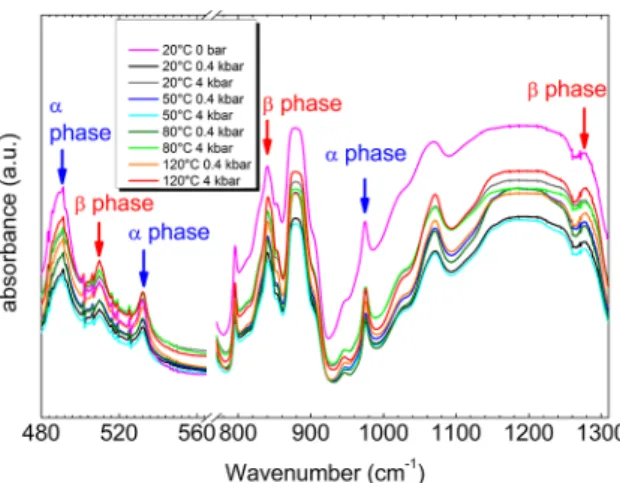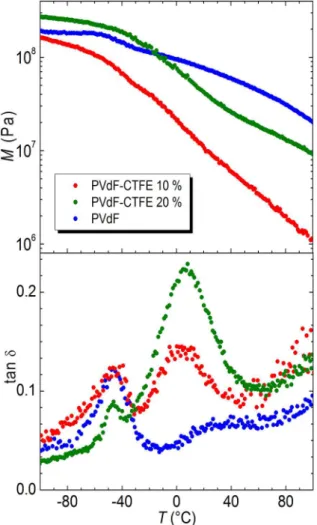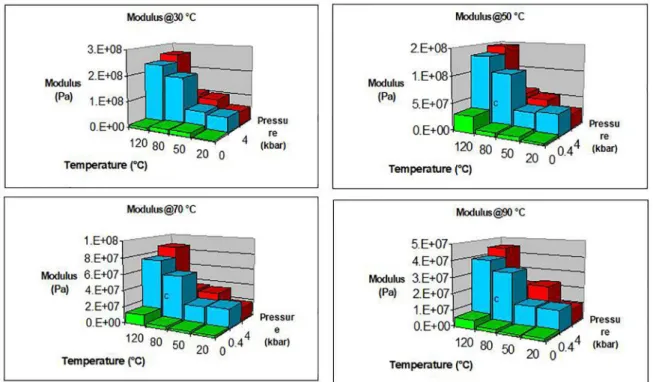Hot Pressing of Electrospun PVdF-CTFE Membranes as Separators for Lithium Batteries:
a Delicate Balance Between Mechanical Properties and Retention
Francesco Trequattrinia,b,* , Oriele Palumbob, Francesco Maria Vituccib, Antonio Miriametrob,
Fausto Crocec, Annalisa Paoloneb
Received: September 28, 2017; Revised: April 05, 2018; Accepted: August 29, 2018
A systematic investigation of the effect of hot-pressing on polyvinylidene fluoride (PVdF) - chlorotrifluoroethylene (CTFE) electrospun membranes, intended as separators and substrate for
the electrolyte of lithium batteries, has been carried out by means of dynamic mechanical analysis. Absorption and desorption gravimetric measurements and infrared spectroscopy have been also performed. In particular, the mechanical properties of the membranes have been measured as a function
of hot pressing temperature and pressure in the range 20 - 120 °C and 0 - 4 kbar, finding an increase of
about 30 times of the tensile modulus after pressing at the highest temperature and pressure. Moreover, the conductivity of hot pressed membranes swelled by an ionic liquid measured as a function of
temperature between - 60 and + 70 °C practically superimposes on that of the unpressed membrane.
Keywords: PVdF, electrospun membrane, hot pressing, retention, elastic modulus.
*e-mail: francesco.trequattrini@roma1.infn.it
1. Introduction
Lithium ion batteries are the state of the art devices for
the storage of energy, as they possess an energy density (210 Wh kg-1, 650 Wh l-1) which exceeds at least by a factor of 2.5
any rivalling technology1. Despite their large availability at
commercial level, many aspects of lithium batteries could
be implemented, for example with the use of electrodes
operating at higher voltage or avoiding the presence of liquid
and flammable electrolytes.
One of the improvable parts of Li-ion cells is the microporous polyolefin separator which is extremely expensive and has poor wetting capability due to its small pore size and porosity. In order to circumvent these drawbacks,
electrospun polymer membranes have been proposed as innovative separators2-11. Among the few polymers that meet the requirements for obtaining of a good polymer
electrolytes, poly (vinylidene fluoride) (PVdF) and its
copolymers, have been found to be very promising as they
have good electrochemical stability and affinity to electrolyte
solutions. However, as prepared electrospun membranes are
very soft and difficult to handle because of their extremely low thickness (in the range of 20 µm) and low mechanical
modulus. In order to avoid such problems, hot pressing of the polymer electrospun membranes has been proposed, but only some sporadic studies are available. He et al.12 studied poly (vinylidene fluoride- trifluoroethylene) electrospun membranes. These authors reported the formation of the β phase of PVdF during the electrospinning process and an
increase of the storage modulus by a factor 2 - 3 after hot
pressing. However, the details of the hot pressing procedure are not given. A broader investigation was reported by Na et al.13 on PVdF electrospun membranes, subject to a hot
rolling process. Na et al. observed a retention of ~ 400% of
the electrospun membrane, that reduces to a value of 100 % when rolling is performed at 100°C and becomes a vanishing
low value for higher rolling temperatures13. Conversely,
the tensile modulus increases as the rolling temperature is
increased. These authors were mainly concerned about the
mechanical properties of the membranes, because they were
intended as filtration systems. The same authors extended the investigation to some blends of PVdF with other polymers, such as polycarbonate and poly(methyl acrilate), confirming
the better mechanical properties of hot rolled membranes14.
Choi et al.8 reported an investigation of the physical properties of PVdF fibers before and after a thermal treatment at 150 °C. The tensile strength and elongation at break as well as
the tensile modulus were notably improved by the thermal treatment.
Lee et al.5 sandwiched two poly(vinylidenefluoride-hexafluoropropylene) and PVdFelectrospun membranes
between the anode and cathode of a lithium battery and
performed hot pressing at 70 °C (at an unknown pressure). Then, dried cells were immersed in 1M LiPF6 in an ethylene
carbonate/dimethyl carbonate/diethyl carbonate/1:1:1, w/w/w) solution for 12 h. The ionic conductivity of the cell after
hot pressing was the same of the cell before hot pressing
(~ 6·10-2 Scm-1) when measured at room temperature and
above, while it was slightly lower for T< 290 K14, 5.
aPhysics Department, Sapienza University of Rome, P.le A. Moro 5, 00185 Roma, Italy bConsiglio Nazionale delle Ricerche, Istituto Dei Sistemi Complessi - CNR-ISC, University of Roma -
U.O.S. La Sapienza, P.le A. Moro 5, 00185 Roma, Italy
The aim of the present paper is to perform a systematic investigation of the effect of hot-pressing mainly on the
mechanical properties of electrospun membranes, intended as separators and substrate for the electrolyte of lithium batteries.
To the best of our knowledge such a detailed investigation
as a function of hot pressing temperature and pressure has never been reported.
2. Materials and Processing
Ultra High Molecular Weight PVdF, PVdF-CTFE 10 % and PVdF-CTFE 20 % were provided by Solvay Fluoropolymers. LP30 solution (EC:DMC 1:1 w/w, 1M LiPF6) was purchased from Merck.
The electrospun membranes were prepared following
a well established procedure by means of a homemade apparatus described in Ref. 7 using a solution prepared at
room temperature by dissolving PVdF-CTFE in acetone: N,N-dimethylacetamide (DMAc) 70:30 v/v at a concentration of 13 % w/v. The typical thickness of the electrospun membranes is in the range 20 - 50 μm.
Pressing was performed in a rectangular shaped die with dimensions of 6 x 40 mm2. The die can be heated by an electric resistance. Each membrane was pressed for 10 minutes at selected temperatures (20, 50, 80 or 120 °C) and pressures (0, 0.4 or 4 kbar).
Infrared spectroscopy measurements were performed by
means of an Agilent Cary 660 spectrometer, equipped with a ceramic source, a KBr beamsplitter and a MCT detector. The spectral resolution was 0.5 cm-1.15
Absorption and desorption of LP30 by the membranes was measured by means of a Mettler Toledo AT261 balance placed in a glove bag with a flowing argon atmosphere in order to prevent contamination of the liquid by water. The absorption was obtained by dropping LP30 on the membrane and removing all the excess liquid by means of optical paper.
The mechanical properties of the membranes were measured by means a Perkin Elmer DMA 8000 in order to
perform dynamic mechanical analysis on small membrane
pieces 4-6 mm wide and 10-12 mm long in the so-called “tension configuration”16-19. The storage modulus, M, and
the elastic energy dissipation, tan δ, were measured at 10 Hz, between - 100 and 100 °C with a temperature rate of 4° C/min.
As a preliminary check of the hot-pressing effect on their
electrochemical properties, the membranes have been swelled
by 1-butyl-1-methylpyrrolidinium bis(trifluoromethanesulfonyl) imide (PYR14- TFSI), which is one of the most promising
ionic liquid studied as electrolytes in lithium batteries20. The
conductivity of the samples has been determined by acquiring impedance spectra at each temperature with a sinusoidal
voltage of 10 mV rms in the frequency range 200 kHz - 1 Hz The samples were positioned in a sample holder between stainless steel disk electrodes 100 micrometers apart and having a diameter of 0.8 cm. The resistance of the sample was determined by extrapolating the high frequency tail of the spectra toward the real axis. The temperature of the samples has been controlled by a Tenney (USA) Environmental Chamber Mod. TJR in the temperature range +70 / -60 °C.
3. Results and Discussion
3.1 Infrared spectroscopy
The infrared spectrum of PVdF-CTFE is dominated from the absorptions due to PVdF21 and indeed all the membranes of PVdF-CTFE 10 % pressed at different temperatures and pressures display clear absorptions around 490,510, 532, 795, 840, 880, 907, 975, 1026, 1068, 1190 and 1278 cm-1
(see Figure 1). The lines centered around 510, 840 and 1275
cm-1 are the fingerprints of the crystalline β phase of PVdF,
while the absorptions around 490, 532 and 975 cm-1 are the
signature of the presence of the α phase22.The other lines are common to both structures of PVdF22.Therefore, one
can conclude that in all membranes both crystalline phases
of PVdF are present. Moreover it seems that the relative concentration of the α and β phase does not drastically
change as a function of heating temperature or pressure, as
the relative intensity of the lines is only slightly affected by
the hot pressing procedure.
3.2 Mechanical properties
Figure 2 shows the temperature dependence of both the
tensile modulus, M, and the elastic energy dissipation, tan
Figure 1. Infrared absorption spectra of the PVdF-CTFE 10 % membranes. The inset indicates the temperature and pressure at
δ, of the PVdF-CTFE 10 % electrospun membrane before any hot pressing procedure (red points). For comparison, also the anelastic spectra of a PVdF-CTFE 20 % membrane (olive points) and of a pure PVdF membrane (blue points) are reported. The glass transitions of PVdF and CTFE polymers, are clearly detected from the peaks in the tan δ data, around - 47 and 6 °C, respectively.
For the PVdF-CTFE 10 % membrane (red points), at
T= 25°C, M is ~ 9·106 Pa andthe modulus displays a typical temperature dependence with a decrease as temperature increases23. In particular, M reaches a value of 1.6·108 Pa at - 100 °C and 1.1 106 Pa at 100 °C.
In order to study the modulus variation as a function of the pressure, php, and the temperature, Thp, of hot pressing, we
performed DMA measurements on all the PVdF-CTFE 10 %
membranes, obtaining curves of M with the same qualitative dependence on T of to those reported in Figure 2. However,
the absolute value of the modulus strongly depends on the
hot pressing conditions (see Figure 3). Indeed, even after
pressing at Thp= 20°C and php= 400 bar, M increases by an
order of magnitude. The elastic modulus further increases
when the temperature and pressure of hot pressing are increased, reaching a value ~ 30 times the value of the as prepared membrane for Thp= 120°C and php= 4 kbar. Figure 3 reports the values of the modulus measured at selected
temperatures for membranes subjected to hot pressing at different temperature and pressure conditions, in particular
it shows that the higher the temperature and pressure of hot pressing, the higher modulus is obtained for the electrospun membranes.
3.3 Retention and release of LP30
Figure 4 reports the retention of all PVdF-CTFE 10 % membranes. Before hot pressing the PVdF-CTFE membrane has a retention of ~ 410 %. Heating the polymer without
pressing does not alter retention, while pressing without
heating slightly decreases retention to ~ 370 %. However the
combination of pressure and temperature further decreases
the retention reaching a value of ~ 300 % for Thp= 80 °C and php= 400 bar and ~ 250 % for Thp= 120°C and php= 4 kbar. It must be noted that in an absolute sense the measured values
of the retention are extremely high. Indeed membranes
obtained by casting polymers24 can have retention of the
order of 400 %, but must be sealed in a closed environment
to avoid release of the liquid.
In the case of the electrospun membrane the release of
LP30 occurs in very long times. Figure 5 displays the mass variation of wet samples as a function of time. The pristine membrane has a mass variation of only 19 % after 24 hours of exposure to flowing argon, and even after 72 hours Δm/m
is 57 %, so that there is still some LP30 left in the sample.
In the case of hot pressed membranes the mass variation is slightly faster, but however the membrane treated at Thp=
80 °C and php= 400 bar displays a mass variation of 32 %
after 24 h and of 75 % after 72 h.
3.4 Conductivity
In Figure 6 the comparison of the temperature dependence of the conductivity of a PVdF membrane swelled by 1-butyl-1-methylpyrrolidinium bis(trifluoromethanesulfonyl)imide (PYR14- TFSI), which is one of the most promising ionic
liquid studied as electrolytes in lithium batteries, and of a
hot pressed membrane (T = 50 °C, p = 4 kbar) of the same polymer is reported. It is noted that the two lines, practically, superimpose one on the other, showing that the hot pressing procedure does not dramatically decrease the conductivity of the system.
Figure 3. Dependence on hot pressing conditions of the tensile modulus of the PVdF-CTFE 10% membranes measured at selected temperatures (30, 50, 70 and 90 °C).
Figure 4. Retention of hot pressed membranes (normalized to the mass of the dry sample).
Figure 5. Time dependence of the mass variation of wet membranes due to the release of LP30.
Figure 6. Temperature dependence of the conductivity of both unpressed and hot pressed membranes swelled with PYR14- TFSI
ionic liquid.
4. Conclusions
The effect of hot-pressing on the tensile modulus measured at various temperatures of polyvinylidene fluoride (PVdF)-10% chlorotrifluoroethylene (CTFE) electrospun
membranes, has been investigated by means of Dynamic Mechanical Analysis, as a function of the pressure, php, and temperature, Thp, used during hot pressing. An increase of the tensile modulus with increasing php, and Thp is obtained, reaching a value of ~ 30 times after pressing at the highest
at ambient p and T, towards ~ 250 % for Thp= 120°C and php=
4 kbar, a value which is still compatible with the application in lithium batteries. Moreover, even when exposed to a argon atmosphere, the release of LP30 occurs in very long times (of the order of 30-70 hours). The conductivity of the system polymer membrane/ionic liquid is only slightly affected by
the hot pressing procedure.
5. References
1. Tarascon JM, Armand M. Issues and challenges facing rechargeable
lithium batteries. Nature. 2001;414(6861):359-367.
2. Li X, Cheruvally G, Kim JK, Choi JW, Ahn JH, Kim KW, et al. Polymer electrolytes based on an electrospun poly (vinylidene fluoride-co-hexafluoropropylene) membrane for lithium batteries. Journal of Power Sources. 2007;167(2):491-498.
3. Cho TH, Sakai T, Tanase S, Kimura K, Kondo Y, Tarao T, et al. Electrochemical Performances of Polyacrylonitrile Nanofiber-based
Nonwoven Separator for Lithium Ion Battery. Electrochemical and Solid-State Letters. 2007;10(7):A159-A162.
4. Gao K, Hu X, Dai C, Yi T. Crystal structures of electrospun PVDF
membranes and its separator application for rechargeable lithium metal cells. Materials Science and Engineering: B. 2006;131(1-3):100-105.
5. Lee SW, Choi SW, Jo SM, Chin BD, Kim DY, Lee KY. Electrochemical properties and cycle performance of electrospun poly(vinylidene fluoride)-based fibrous membrane electrolytes for Li-ion polymer
battery. Journal of Power Sources. 2006;163(1):41-46.
6. Kim JR, Choi SW, Jo SM, Lee WS, Kim BC. Characterization and Properties of P(VdF-HFP)-Based Fibrous Polymer Electrolyte Membrane Prepared by Electrospinning. Journal of the Electrochemical Society. 2005;152(2):A295-A300.
7. Croce F, Focarete ML, Hassoun J, Meschini I, Scrosati B. A safe, high-rate and high-energy polymer lithium-ion battery based
on gelled membranes prepared by electrospinning. Energy & Environmental Science. 2011;4(3):921-927.
8. Choi SS, Lee YS, Joo CW, Lee SG, Park JK, Han KS. Electrospun PVDF nanofiber web as polymer electrolyte or separator. Electrochimica Acta. 2004;50:339-343.
9. Choi SW, Kim JR, Jo SM, Lee WS, Kim YR. Electrochemical and Spectroscopic Properties of Electrospun PAN-Based Fibrous Polymer Electrolytes. Journal of the Electrochemical Society.
2005;152(5):A989-A995.
10. Raghavan P, Manuel J, Zhao X, Kim DS, Ahn JH, Nah C. Preparation and electrochemical characterization of gel polymer
electrolyte based on electrospun polyacrylonitrile nonwoven membranes for lithium batteries. Journal of Power Sources.
2011;196(16):6742-6749.
11. Aurbach D, Markovsky B, Salitra G, Markevich E, Talyossef Y, Koltypin M, et al. Review on electrode-electrolyte solution interactions, related to cathode materials for Li-ion batteries. Journal of Power Sources. 2007;165(2):491-499.
12. He F, Sarkar M, Lau S, Fan J, Chan LH. Preparation and characterization of porous poly (vinylidene fluoride-trifluoroethylene) copolymer membranes via electrospinning
and further hot pressing. Polymer Testing. 2011;30(4):436-441.
13. Na H, Zhao Y, Zhao C, Zhao C, Yuan X. Effect of hot-press on electrospun poly(vinylidene fluoride) membranes. Polymer Engineering and Science. 2008;48(5):934-940.
14. Na H, Zhao Y, Liu X, Zhao C, Yuan X. Structure and properties of electrospun poly(vinylidene fluoride)/polycarbonate membranes after hot-press. Journal of Applied Polymer Science. 2011;122(2):774-781.
15. Vitucci FM, Trequattrini F, Palumbo O, Brubach JB, Roy P, Paolone A. Infrared spectra of bis(trifluoromethanesulfonyl) imide based ionic liquids: Experiments and DFT simulations. Vibrational Spectroscopy. 2014;74:81-87.
16. Vitucci FM, Manzo D, Navarra MA, Palumbo O, Trequattrini F, Panero S, et al. Low-Temperature Phase Transitions of 1-Butyl-1-methylpyrrolidinium Bis(trifluoromethanesulfonyl) imide Swelling a Polyvinylidenefluoride Electrospun Membrane. Journal of Physical Chemistry C. 2014;118(11):5749-5755.
17. Teocoli F, Paolone A, Palumbo O, Navarra MA, Casciola M, Donnadio A. Effects of water freezing on the mechanical properties of nafion membranes. Journal of Polymer Science Part B: Polymer Physics. 2012;50(20):1421-1425.
18. Scipioni R, Gazzoli D, Teocoli F, Palumbo O, Paolone A, Ibris N, et al. Preparation and Characterization of Nanocomposite Polymer Membranes Containing Functionalized SnO2 Additives. Membranes (Basel). 2014;4(1):123-142.
19. Paolone A, Palumbo O, Rispoli P, Cantelli R, Rönnebro E, Luetdtke A, et al. Release of Tetrahydrofuran, Structural Phase Transitions and Dynamic Relaxation Processes in Ca (BH4)2. Solid State Phenomena. 2012;184:24-32.
20. Martinelli A, Matic A, Jacobsson P, Bo¨rjesson L. Phase Behavior and Ionic Conductivity in Lithium Bis(trifluoromethanesulfonyl) imide-Doped Ionic Liquids of the Pyrrolidinium Cation and Bis(trifluoromethanesulfonyl)imide Anion. Journal of Physical Chemistry B. 2009;113(32):11247-11251.
21. Wang J, Zheng L, Wu Z, Zhang Y, Zhang X. Fabrication of hydrophobic flat sheet and hollow fiber membranes from PVDF and PVDF-CTFE for membrane distillation. Journal of Membrane Science. 2016;497:183-193.
22. Kobayashi M, Tashiro K, Tadokoro H. Molecular Vibrations of Three Crystal Forms of Poly(vinylidene fluoride). Macromolecules. 1975;8(2):158-171.
23. Liu Z, Maréchal P, Jérôme R. D.m.a. and d.s.c. investigations of the ß transition of poly(vinylidene fluoride). Polymer.
1997;38(19):4925-4929.


